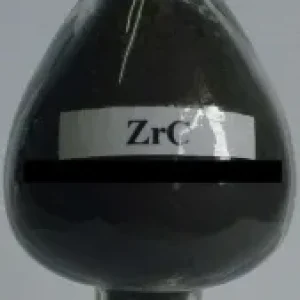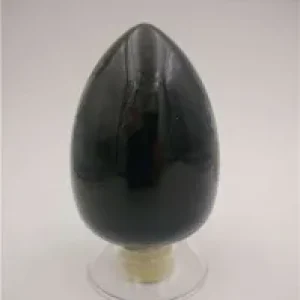Overview of Tantalum Carbide TaC Powder
Tantalum carbide is a metallic cubic crystalline powder that forms a binary chemical compound family of tantalum and carbon. They are extremely hard, fragile, refractory ceramic materials with metallic conductivity. They appear as brownish-gray powders and are usually processed by sintering. It belongs to the sodium chloride type cubic crystal system. At present, tantalum carbide is also used as a cemented carbide sintered grain growth inhibitor, which significantly inhibits grain growth, with a density of 14.3g/cm3.
Tantalum carbide is insoluble in water, hardly soluble in inorganic acid, in a mixed acid of hydrofluoric acid and nitric acid, and can decompose. Strong oxidation resistance, easily melted and decomposed by potassium pyrosulfate. Tantalum carbide has high electrical conductivity, with a resistance of 30Ω at room temperature, showing superconducting properties. Tantalum carbide can be used in powder metallurgy, cutting tools, fine ceramics, chemical vapor deposition, hard wear-resistant alloy tools, tools, molds, and wear-resistant and corrosion-resistant structural components to improve the toughness of the alloy. The sintered body of tantalum carbide is golden yellow and can be used as a watch decoration.
The bond between tantalum carbide and carbon atoms is a complex mixture of ions, metals, and covalent contributions, and these carbides have very hard and brittle materials due to strong covalent components. For example, TaC has a microhardness of 1600-2000 kg/mm2 (~9μH) and an elastic modulus of 285gPa, and the corresponding values of tantalum are 110kg/mm2 and 186gPa. The carbon content in TAC increases hardness, yield, and shear stress.
As an important cermet material, tantalum carbide is sometimes added to the tungsten carbide alloy when commercially used for cutting applications.
Tantalum carbide melting point: Depending on the purity and measurement conditions, the melting point of tantalum carbide reaches its peak at about 3880°C. This value is the highest value among binary compounds. Only tantalum carbide ha can have a slightly higher melting point of about 3942°C, while the melting point of carbide clam is comparable to TaC.
Technical parameters of Tantalum carbide TaC powder
CAS number: 12070-06-3
Tantalum carbide TaC powder True Density: 13.9 g/cm3
Tantalum carbide TaC powder Bulk Density: 2.5g/cm3
Tantalum carbide TaC powder Crystal Structure: Cubic
Tantalum carbide TaC powder APS: 1000 nm (Can be customized)
Tantalum carbide TaC powder SSA: 15 m2/g
Tantalum carbide TaC powder Purity: 99+%
Tantalum carbide TaC powder Solubility in water: insoluble
Tantalum carbide TaC powder Appearance: Black-gray odorless powder
|
T.C |
F.C | O | N | Al | Fe | Na | Ca | K |
Si |
| >6.32% | <0.08% | <0.3% | <0.003% | <0.004% | <0.042% | <0.003% | <0.003% | <0.004% |
<0.003% |
Properties of Tantalum Carbide
Tantalum carbide TaC is an extremely hard (Mohs hardness 9-10) refractory ceramic material commercially used in tool bits for cutting tools. The diamond exceeds the hardness.
It is a heavy, brown powder usually processed by sintering and an important cermet material.
It is sometimes used as a fine-crystalline additive to tungsten carbide alloys.
Tantalum carbide is the stoichiometric binary compound with the highest known melting point, at 4150 K (3880°C), and boiling point at 5500 C.
The substoichiometric compound TaC0.89 has a higher melting point, near 4270 K (4000°C).
Production Method of Tantalum Carbide TaC Powder produced
The Tac powder of the desired composition is prepared by adding a mixture of heating and graphite powder in a vacuum or an inert gas atmosphere (argon). The heating was performed at about 2000 ° C using a furnace or arc melting. The alternative technology is reduced by carbon tantalum oxide in a vacuum or hydrogen atmosphere at 1500-1700 ° C. This method was used for carbonized tantalum in 1876 but lacked thermometrically controlled product control. Direct production TAC is produced directly from the component by self-propagating high-temperature synthesis.
Applications of Tantalum Carbide
The main use of tantalum carbide is carbide, capacitors, electronic devices, high-temperature components, chemical equipment, and ferrite. Carbides are typically added to tungsten carbide/cobalt (WC / CO) powder wear to enhance the physical properties of the sintering structure.
The tantalum carbide also serves as a grain growth inhibitor to prevent large particles from forming a material to produce an optimum hardness.
It is also used as steel mold coatings in aluminum alloy injection molding. While providing hard, wear-resistant surfaces, it also provides low-friction mold surfaces.
Carbides are also used to produce sharp instruments with extreme mechanical resistance and hardness. In addition, tantalum carbide can also be used in the following:
1. Cemented carbide
The tantalum carbide plays an important role in the cemented carbide, improving alloy properties by improving fibrous tissue and phase transformation kinetics, making alloys stronger, more stable, and processing deformation.
2. Electronic industry
Natunction inherits many advantages of carbide nanomaterials and has its unique side. Such as high hardness (normal temperature is 9-10, high melting point (approximately 3880 ° C), Yang’s modulus (283-550 GPa), strong conductivity (32.7-117.4 μΩ · CM at 25 ° C in electrical conductivity) ), High-temperature superconducting (10.5k), anti-chemical corrosion candles and heat shock ability, highly catalytic activity of ammonia decomposition and hydrogen separation.
3. High-temperature alloy
In carbide, the melting is preferably a tantalum carbide(TAC) (melting point 3890 ° C) and carbide (HFC) (melting point 3880 ° C), followed by carbide (ZrC) (melting point 3500 ° C). These materials have excellent mechanical properties at high temperatures that greatly exceed the best polycrystalline graphite, especially carbonized, the only material that maintains certain mechanical properties in the temperature range of 2900 ° C-3200 ° C.
Company Profile
My Carbides is a trusted global chemical material supplier & manufacturer with over 12-year-experience in providing super high-quality carbides and relatives products.
The company has a professional technical department and Quality Supervision Department, a well-equipped laboratory, and equipped with advanced testing equipment and after-sales customer service center.If you are looking for high-quality Carbides, please feel free to contact us or click on the needed products to send an inquiry.
Storage Condition of Tantalum Carbide TaC Powder
The damp reunion will affect TaC powder dispersion performance and using effects, therefore, Tantalum carbide TaC powder should be sealed in vacuum packing and stored in cool and dry room, the Tantalum carbide TaC powder can not be exposure to air. In addition, the Ti2AlC powder should be avoided under stress.
Payment Methods of Tantalum Carbide TaC Powder
L/C, T/T, Western Union, Paypal, Credit Card etc.
Shipment of Tantalum Carbide TaC Powder
It could be shipped by sea, by air, or by reveal ASAP as soon as repayment receipt.
Package of Tantalum Carbide TaC Powder
Vacuum packing, 100g, 500g or 1kg/bag, 25kg/barrel, or as your request.
FAQ
Q1: What is the melting point of tantalum carbide?
Answer: The melting point of tantalum carbide is very high, reaching 3880°C.
Q2: What is the hardness of tantalum carbide?
Answer: Tantalum carbide has a very high hardness, with a hardness value of 9 to 10.
Q3: What is the electrical conductivity of tantalum carbide?
Answer: Tantalum carbide has excellent electrical conductivity, with a resistance of 30Ω at room temperature, showing superconducting properties.
Q4: Is tantalum carbide easily soluble in water and inorganic acids?
Answer: Tantalum carbide is insoluble in water and difficult to dissolve in inorganic acids, but it can be soluble in a mixed acid of hydrofluoric acid and nitric acid.
Q5: What is the antioxidant capacity of tantalum carbide?
Answer: Tantalum carbide has strong antioxidant capacity, and it is easily melted and decomposed by potassium pyrosulfate.
Q6: What is the role of tantalum carbide in cemented carbide manufacturing?
Answer: Tantalum carbide is used as a sintering grain growth inhibitor in cemented carbide manufacturing. It has a significant effect on inhibiting grain growth, thereby improving the toughness of the alloy.
Q7: What color does tantalum carbide powder show after sintering?
Answer: Tantalum carbide powder will turn golden yellow after sintering. This characteristic makes it useful as watch decoration.
Q8: Is tantalum carbide harmful to the human body?
Answer: Tantalum carbide itself is not directly toxic, but inhaling its dust for a long time may cause irritation or damage to the lungs. Therefore, when working with tantalum carbide, appropriate protective equipment should be worn and the workplace should be well ventilated.







